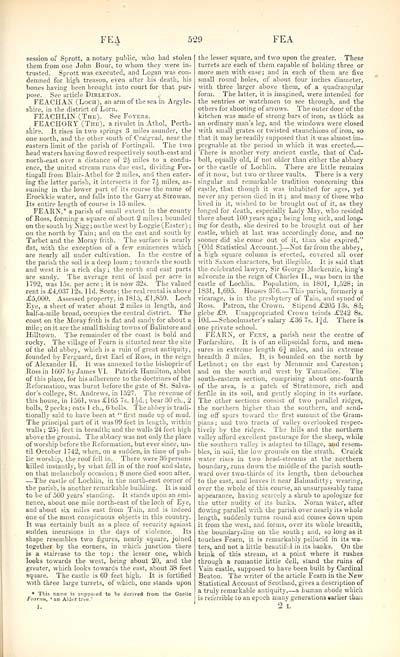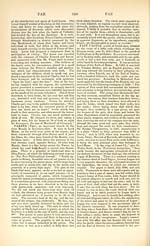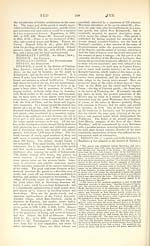Topographical, statistical, and historical gazetteer of Scotland > Volume 1
(623) Page 529
Download files
Complete book:
Individual page:
Thumbnail gallery: Grid view | List view

FEA
529
FEA
session of Sprott, a notary public, who bad stolen
tbern from one John Bour, to wbom tbey were in-
trusted. Sprott was executed, and Logan was con-
demned for bigb treason, even after bis death, bis
bones having been brought into court for that. pur-
pose. See article Dikleton.
FEACHAN (Loch), an arm of the sea in Argyle-
shire, in the district of Lorn.
FEACHLIN (The). See Foyers.
. FEACHORY (The), a rivulet in Athol, Perth-
shire. It rises in two springs 3 miles asunder, the
one north, and the other south of Craigvad, near the
eastern limit of the parish of Fortingall. The two
head waters having flowed respectively south-east and
north-east over a distance of 2h miles to a conflu-
ence, the united stream runs due east, dividing For-
tingall from Blair- Athol for 2 miles, and then enter-
ing the latter parish, it intersects it for 7J miles, as-
suming in the lower part of its course the name of
Erockkie water, and falls into the Garry at Strowan.
Its entire length of course is 13 miles.
FEARN,* a parish of small extent in the county
of Ross, forming a square of about 2 miles ; bounded
on the south by Nigg ; on the west by Loggie (Easter) ;
on the north by Tain; and on the east and south by
Tarbet and the Moray frith. The surface is nearly
flat, with the exception of a few eminences which
are nearly all under cultivation. In the centre of
the parish the soil is a deep loam ; towards the south
and west it is a rich clay ; the north and east parts
are sandy. The average rent of land per acre in
1792, was 15s. per acre ; it is now 32s. The valued
rent is £4,037 12s. lid. Scots; the real rental is above
£5,000. Assessed property, in 1815, £1,859. Loch
Eye, a sheet of water about 2 miles in length, and
half-a-mile broad, occupies the central district. The
coast on the Moray frith is flat and sandy for about a
mile ; on it are the small fishing towns of Balintore and
Hilltown. The remainder of the coast is bold and
rocky. The village of Fearn is situated near the site
of the old abbey, which is a ruin of great antiquity,
founded by Ferguard, first Earl of Ross, in the reign
of Alexander II. It was annexed to the bishopric of
Ross in 1607 by James VI. Patrick Hamilton, abbot
of this place, for his adherence to the doctrines of the
Reformation, was burnt before the gate of St. Salva-
dor's college, St. Andrews, in 1527. The revenue of
this house, in 1561, was £165 7s. Hd. ; bear 30 cb., 2
bolls, 2 pecks ; oats 1 ch., 6 bolls. The abbey is tradi-
tionally said to have been at "first made up of mud.
The principal part of it was 99 feet in length, within
walls ; 25i feet in breadth; and the walls 24 feet high
above the ground. The abbacy was not only the place
of worship before the Reformation, but ever since, un-
til October 1742, when, on a sudden, in time of pub-
lic worship, the roof fell in. There were 36 persons
killed instantly, by what fell in of the roof and slate,
on that melancholy occasion ; 8 more died soon after.
— The castle of Lochlin, in the north-east corner of
the parish, is another remarkable building. It is said
to be of 500 years' standing. It stands upon an emi-
nence, about one mile north-east of the loch of Eye,
and about six miles east from Tain, and is indeed
one of the most conspicuous objects in this country.
It was certainly built as a place of security against
sudden incursions in the days of violence. Its
shape resembles two figures, nearly square, joined
together by the corners, in which junction there
is a staircase to the top : the lesser one, which
looks towards the west, being about 20, and the
greater, which looks towards the east, about 38 feet
square. The castle is 60 feet high. It is fortified
with three large turrets, of which, one stands upon
* This name i3 supposed to be derived from the Gaelic
Fearnn, ' an Alder tree.'
I.
the lesser square, and two upon the greater. These
turrets are each of them capable of holding three or
more men with ease; and in each of them are five
small round holes, of about four inches diameter,
with three larger above them, of a quadrangular
form. The latter, it is imagined, were intended for
the sentries or watchmen to see through, and the
others for shooting of arrows. The outer door of the
kitchen was made of strong bars of iron, as thick as
an ordinary man's leg, and the windows were closed
with small grates or twisted staunchions of iron, so
that it may be readily supposed that it was almost im-
pregnable at the period in which it was erected
There is another very ancient castle, that of Cad-
boll, equally old, if not older than either the abbacy
or the castle of Lochlin. There are little remains
of it now, but two or three vaults. There is a very
singular and remarkable tradition concerning this
castle, that though it was inhabited for ages, yet
never any person died in it ; and many of those who
lived in it, wished to be brought out of it, as they
longed for death, especially Lady May, who resided
there about 100 years ago ; being long sick, and long-
ing for death, she desired to be brought out of her
castle, which at last was accordingly done, and no
sooner did she come out of it, than she expired."
[Old Statistical Account.] — Not far from the abbey,
a high square column is erected, covered all over
with Saxon characters, but illegible. It is said that
the celebrated lawyer, Sir George Mackenzie, king's
advocate in the reign of Charles II., was born in the
castle of Lochlin. Population, in 1801, 1,528; in
1831, 1,695. Houses 376. — This parish, formerly a
vicarage, is in the presbytery of Tain, and synod of
Ross. Patron, the Crown. Stipend £205 13s. 8d;
glebe £9. Unappropriated Crown teinds £242 8s.
lOd Schoolmaster's salary £36 7s. ljd. There is
one private school.
FEARN, or Fern, a parish near the centre of
Forfarshire. It is of an ellipsoidal form, and mea-
sures in extreme length 6% miles, and in extreme
breadth 3 miles. It, is bounded on the north by
Lethnot ; on the east by Menmuir and Careston ;
and on the south and west by Tannadice." The
south-eastern section, comprising about one-fourth
of the area, is a patch of Strathmore, rich and
fertile in its soil, and gently sloping in its surface.
The other sections consist of two parallel ridges,
the northern higher than the southern, and send-
ing off spurs toward the first summit of the Gram-
pians; and two tracts of valley overlooked respec-
tively by the ridges. The hills and the northern
valley afford excellent pasturage for the sheep, while
the southern valley is adapted to tillage, and resem-
bles, in soil, the low grounds on the strath. Cruick
water rises in two head-streams at the northern
boundary, runs down the middle of the parish south-
ward over two-thirds of its length, then debouches
to the east, and leaves it near Balmaditty; wearing,
over the whole of this course, an unsurpassably tame
appearance, having scarcely a shrub to apologize for
the utter nudity of its banks. Noran water, after
flowing parallel with the parish over nearly its whole
length, suddenly turns round and comes down upon
it from the west, and forms, over its whole breadth,
the boundary-line on the south ; and, so long as it
touches Fearn, it is remarkably pellucid in its wa-
ters, and not a little beautiful in its banks. On the
brink of this stream, at a point where it rushes
through a romantic little dell, stand the ruins of
Vain castle, supposed to have been built by Cardinal
Beaton. The writer of the article Fearn in the New
Statistical Account of Scotland, gives a description of
a truly remarkable antiquity, — a human abode which
is referable to an epoch many generations earlier than
2 L
529
FEA
session of Sprott, a notary public, who bad stolen
tbern from one John Bour, to wbom tbey were in-
trusted. Sprott was executed, and Logan was con-
demned for bigb treason, even after bis death, bis
bones having been brought into court for that. pur-
pose. See article Dikleton.
FEACHAN (Loch), an arm of the sea in Argyle-
shire, in the district of Lorn.
FEACHLIN (The). See Foyers.
. FEACHORY (The), a rivulet in Athol, Perth-
shire. It rises in two springs 3 miles asunder, the
one north, and the other south of Craigvad, near the
eastern limit of the parish of Fortingall. The two
head waters having flowed respectively south-east and
north-east over a distance of 2h miles to a conflu-
ence, the united stream runs due east, dividing For-
tingall from Blair- Athol for 2 miles, and then enter-
ing the latter parish, it intersects it for 7J miles, as-
suming in the lower part of its course the name of
Erockkie water, and falls into the Garry at Strowan.
Its entire length of course is 13 miles.
FEARN,* a parish of small extent in the county
of Ross, forming a square of about 2 miles ; bounded
on the south by Nigg ; on the west by Loggie (Easter) ;
on the north by Tain; and on the east and south by
Tarbet and the Moray frith. The surface is nearly
flat, with the exception of a few eminences which
are nearly all under cultivation. In the centre of
the parish the soil is a deep loam ; towards the south
and west it is a rich clay ; the north and east parts
are sandy. The average rent of land per acre in
1792, was 15s. per acre ; it is now 32s. The valued
rent is £4,037 12s. lid. Scots; the real rental is above
£5,000. Assessed property, in 1815, £1,859. Loch
Eye, a sheet of water about 2 miles in length, and
half-a-mile broad, occupies the central district. The
coast on the Moray frith is flat and sandy for about a
mile ; on it are the small fishing towns of Balintore and
Hilltown. The remainder of the coast is bold and
rocky. The village of Fearn is situated near the site
of the old abbey, which is a ruin of great antiquity,
founded by Ferguard, first Earl of Ross, in the reign
of Alexander II. It was annexed to the bishopric of
Ross in 1607 by James VI. Patrick Hamilton, abbot
of this place, for his adherence to the doctrines of the
Reformation, was burnt before the gate of St. Salva-
dor's college, St. Andrews, in 1527. The revenue of
this house, in 1561, was £165 7s. Hd. ; bear 30 cb., 2
bolls, 2 pecks ; oats 1 ch., 6 bolls. The abbey is tradi-
tionally said to have been at "first made up of mud.
The principal part of it was 99 feet in length, within
walls ; 25i feet in breadth; and the walls 24 feet high
above the ground. The abbacy was not only the place
of worship before the Reformation, but ever since, un-
til October 1742, when, on a sudden, in time of pub-
lic worship, the roof fell in. There were 36 persons
killed instantly, by what fell in of the roof and slate,
on that melancholy occasion ; 8 more died soon after.
— The castle of Lochlin, in the north-east corner of
the parish, is another remarkable building. It is said
to be of 500 years' standing. It stands upon an emi-
nence, about one mile north-east of the loch of Eye,
and about six miles east from Tain, and is indeed
one of the most conspicuous objects in this country.
It was certainly built as a place of security against
sudden incursions in the days of violence. Its
shape resembles two figures, nearly square, joined
together by the corners, in which junction there
is a staircase to the top : the lesser one, which
looks towards the west, being about 20, and the
greater, which looks towards the east, about 38 feet
square. The castle is 60 feet high. It is fortified
with three large turrets, of which, one stands upon
* This name i3 supposed to be derived from the Gaelic
Fearnn, ' an Alder tree.'
I.
the lesser square, and two upon the greater. These
turrets are each of them capable of holding three or
more men with ease; and in each of them are five
small round holes, of about four inches diameter,
with three larger above them, of a quadrangular
form. The latter, it is imagined, were intended for
the sentries or watchmen to see through, and the
others for shooting of arrows. The outer door of the
kitchen was made of strong bars of iron, as thick as
an ordinary man's leg, and the windows were closed
with small grates or twisted staunchions of iron, so
that it may be readily supposed that it was almost im-
pregnable at the period in which it was erected
There is another very ancient castle, that of Cad-
boll, equally old, if not older than either the abbacy
or the castle of Lochlin. There are little remains
of it now, but two or three vaults. There is a very
singular and remarkable tradition concerning this
castle, that though it was inhabited for ages, yet
never any person died in it ; and many of those who
lived in it, wished to be brought out of it, as they
longed for death, especially Lady May, who resided
there about 100 years ago ; being long sick, and long-
ing for death, she desired to be brought out of her
castle, which at last was accordingly done, and no
sooner did she come out of it, than she expired."
[Old Statistical Account.] — Not far from the abbey,
a high square column is erected, covered all over
with Saxon characters, but illegible. It is said that
the celebrated lawyer, Sir George Mackenzie, king's
advocate in the reign of Charles II., was born in the
castle of Lochlin. Population, in 1801, 1,528; in
1831, 1,695. Houses 376. — This parish, formerly a
vicarage, is in the presbytery of Tain, and synod of
Ross. Patron, the Crown. Stipend £205 13s. 8d;
glebe £9. Unappropriated Crown teinds £242 8s.
lOd Schoolmaster's salary £36 7s. ljd. There is
one private school.
FEARN, or Fern, a parish near the centre of
Forfarshire. It is of an ellipsoidal form, and mea-
sures in extreme length 6% miles, and in extreme
breadth 3 miles. It, is bounded on the north by
Lethnot ; on the east by Menmuir and Careston ;
and on the south and west by Tannadice." The
south-eastern section, comprising about one-fourth
of the area, is a patch of Strathmore, rich and
fertile in its soil, and gently sloping in its surface.
The other sections consist of two parallel ridges,
the northern higher than the southern, and send-
ing off spurs toward the first summit of the Gram-
pians; and two tracts of valley overlooked respec-
tively by the ridges. The hills and the northern
valley afford excellent pasturage for the sheep, while
the southern valley is adapted to tillage, and resem-
bles, in soil, the low grounds on the strath. Cruick
water rises in two head-streams at the northern
boundary, runs down the middle of the parish south-
ward over two-thirds of its length, then debouches
to the east, and leaves it near Balmaditty; wearing,
over the whole of this course, an unsurpassably tame
appearance, having scarcely a shrub to apologize for
the utter nudity of its banks. Noran water, after
flowing parallel with the parish over nearly its whole
length, suddenly turns round and comes down upon
it from the west, and forms, over its whole breadth,
the boundary-line on the south ; and, so long as it
touches Fearn, it is remarkably pellucid in its wa-
ters, and not a little beautiful in its banks. On the
brink of this stream, at a point where it rushes
through a romantic little dell, stand the ruins of
Vain castle, supposed to have been built by Cardinal
Beaton. The writer of the article Fearn in the New
Statistical Account of Scotland, gives a description of
a truly remarkable antiquity, — a human abode which
is referable to an epoch many generations earlier than
2 L
Set display mode to: Large image | Transcription
Images and transcriptions on this page, including medium image downloads, may be used under the Creative Commons Attribution 4.0 International Licence unless otherwise stated. ![]()
| Gazetteers of Scotland, 1803-1901 > Topographical, statistical, and historical gazetteer of Scotland > Volume 1 > (623) Page 529 |
|---|
| Permanent URL | https://digital.nls.uk/97445022 |
|---|
| Description | Volume first. A-H. |
|---|---|
| Attribution and copyright: |
|

